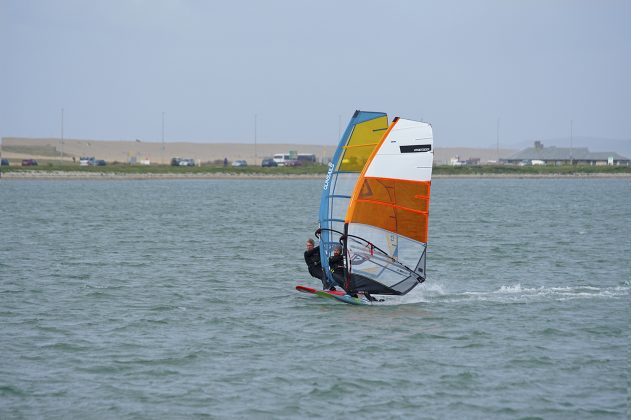7.5 NO-CAM FREERIDE SAIL TEST 2020
The kit for the latest test managed to arrive in time for the test team to get out on the water before the lockdown, for our May issue. On the menu this month is no-cam freeride contenders … and here is the test team’s findings.
This test was originally published in the May 2020 issue of Windsurf Magazine.
TEST EDITOR: TRIS BEST
SECOND TESTERS: MAURIN ROTTENWALTER, JOE NORTH AND DAN HALLAM
PHOTOS: JOE NORTH
TEST LOCATION: OTC WEYMOUTH
FINDINGS
Whilst the ‘no-cam freeride’ sail category looks rather straightforward at first glance, the interpretation by each brand leads them down their own individual design pathways, resulting in some very different options on the market. It’s not a bad situation at all for you or I, the end consumer, but an important step is to unpick what’s available and make sure you get the sail (and performance) appropriate for your sailing ability and style. Freeride, performance freeride, freerace or no-cam slalom … call it what you will, the brief for all the sails is largely made up of the search for the same qualities: ease of use (both on land, whilst rigging, and on water), performance (straight-line and around corners) and range. The varying emphasis that each loft puts upon these qualities ultimately determines the sort of sail they end up with in their lineup. Some have focussed on ease of use, making their product super user-friendly, requiring minimal technical input in fine-tuning or on the water. Others have focussed on top-end performance, designing their sail to feel fiercely competitive in a straight-line. Others have targeted the other end of the wind spectrum and charged their sail with the minerals to push bottom end grunt to get planing as early as possible. Finding a balance between all the qualities is a focus for some therefore, aiming to give their sail top honours in the ‘all-rounder’ category.
The point worth making is that all these sails work incredibly well, regardless of any particular leaning they may have. There simply are no duds here. The ability to vary luff curves, use new materials in critical panels or employ specific shaping techniques, to achieve the right feel and power delivery, has become a real art form. Spending time on the water with these sails has left us in no doubt that each brand is 100% focussed on this sector of the market. And rightly so, considering it is the largest.
SUMMARY
Duotone have introduced a new 3-in-1 concept in the E_Pace, with its reduced luff curve and wide tuning range, aimed at delivering performance in light wind freeride, high wind freerace and wind-foiling. And we have to say it works very well indeed. Just be prepared to spend time experimenting with its set to fully appreciate its capabilities. At the other end of the scale, the GA Sails Hybrid is a straightforward plug-and-play freeride engine, requiring minimal fuss or knowledge in tuning. Just rig in minutes and enjoy getting out on the water! And if the Hybrid should be deemed passive in nature, the Goya is the ‘Yang’ to GA Sails’ ‘Yin’. The Mark Pro is active in encouraging rider involvement and provides a captivating ride that the more energetic sailor will thrive with. The Cheetah from Ezzy has been refined for 2020, using lighter more exacting materials to produce a similar change in its feel and response. It still provides a familiar constant drive and feedback, yet offers more precision in its delivery. Onto two sails that deserve high acclaim for their top end performances, we have the Speedster from Neil Pryde and the AC-X from Point-7. Both are electric and inspiring when fully powered, yet have subtly different methods in achieving their performance. The Speedster uses some careful engineering to cement the position of the sail’s centre of effort further back and around the rider, refining the entry of its leading edge and the rest of the sail’s twist pattern. It makes the sail such an efficient and seductive engine to use, making use of every iota of the wind’s energy. The AC-X on the other hand uses an understated but intelligent luff panel addition that serves to take control of the sail’s character the stronger the wind becomes. That leaves the three all-rounders in the group – the Loftsails Oxygen, Gunsails Rapid and RRD Fire. All three work well across impressive wind ranges, are compatible with varying board types and with different rider abilities / sailing styles. RRD has refocussed the Fire’s remit to commission its newfound versatility; the Rapid, like all Gunsails tested so far this season, represents excellent value for money; and the Oxygen has such poise and tactility across an extraordinary natural range that it can’t help but bring a smile to your face.
And ultimately, that ‘smile on your face’ is the core value or goal of this ‘freeride’ sail category. More than that, it’s the sole underlying attraction of our beloved sport. All these sails are designed primarily to get you out on the water … to experience the great outdoors and have an adventure. And I can tell you now, that liberating life-affirming sensation of blasting across the water is not going to be lost on any of us when we return to the water soon. Stay safe everyone.
THE LINE UP


